Internet of Things: Security and Privacy
VerifiedAdded on 2020/05/11
|15
|4799
|77
AI Summary
This assignment delves into the complex landscape of security and privacy concerns within the Internet of Things (IoT). It examines various research papers that highlight the unique vulnerabilities and potential threats associated with interconnected devices. The focus is on understanding the challenges posed by data breaches, distributed denial-of-service attacks, and the need for robust security measures to protect user privacy in an increasingly connected world.
Contribute Materials
Your contribution can guide someone’s learning journey. Share your
documents today.

Running head: CYBER CRIME 0
Cyber Crime
Cyber Crime
Secure Best Marks with AI Grader
Need help grading? Try our AI Grader for instant feedback on your assignments.
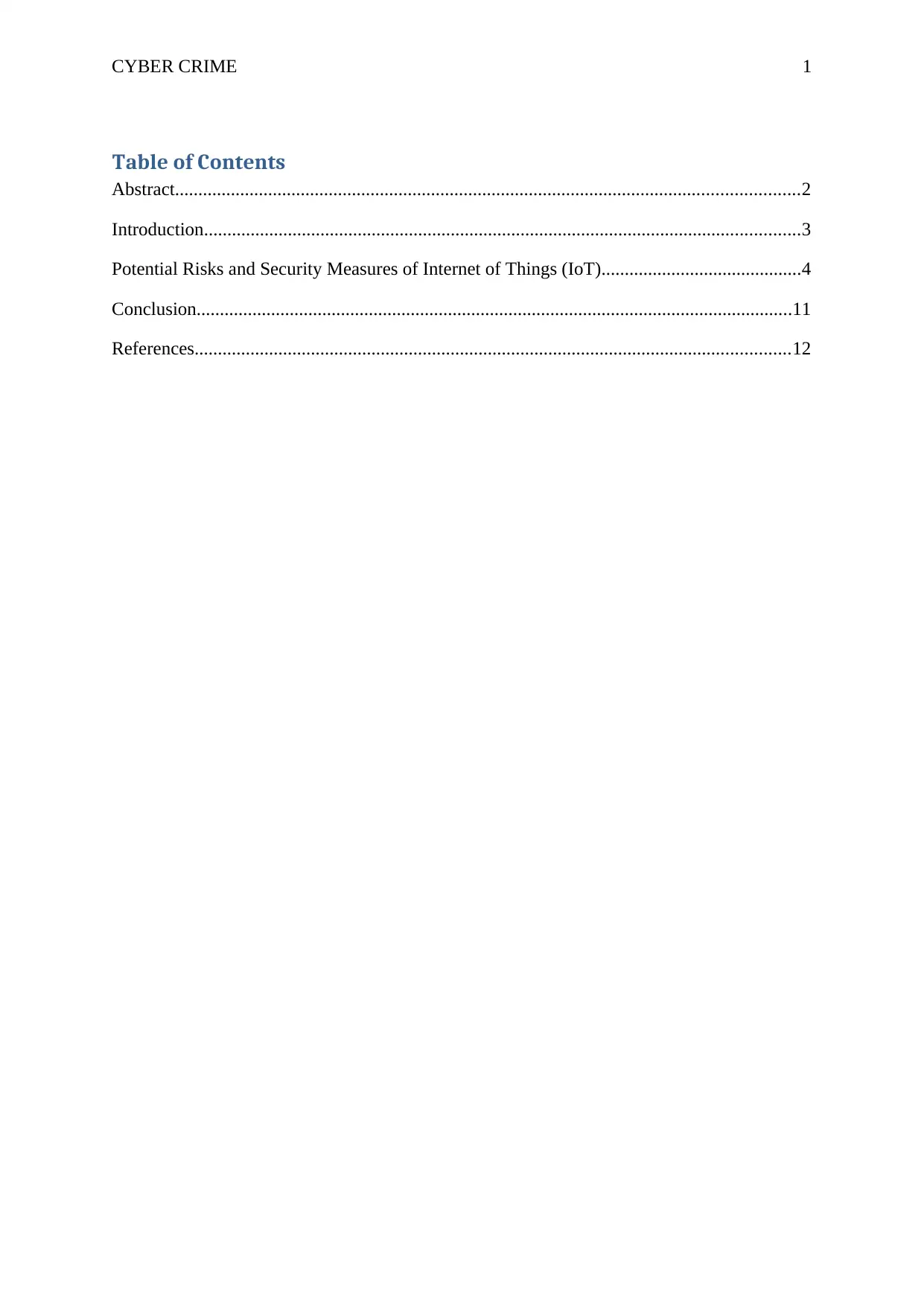
CYBER CRIME 1
Table of Contents
Abstract......................................................................................................................................2
Introduction................................................................................................................................3
Potential Risks and Security Measures of Internet of Things (IoT)...........................................4
Conclusion................................................................................................................................11
References................................................................................................................................12
Table of Contents
Abstract......................................................................................................................................2
Introduction................................................................................................................................3
Potential Risks and Security Measures of Internet of Things (IoT)...........................................4
Conclusion................................................................................................................................11
References................................................................................................................................12
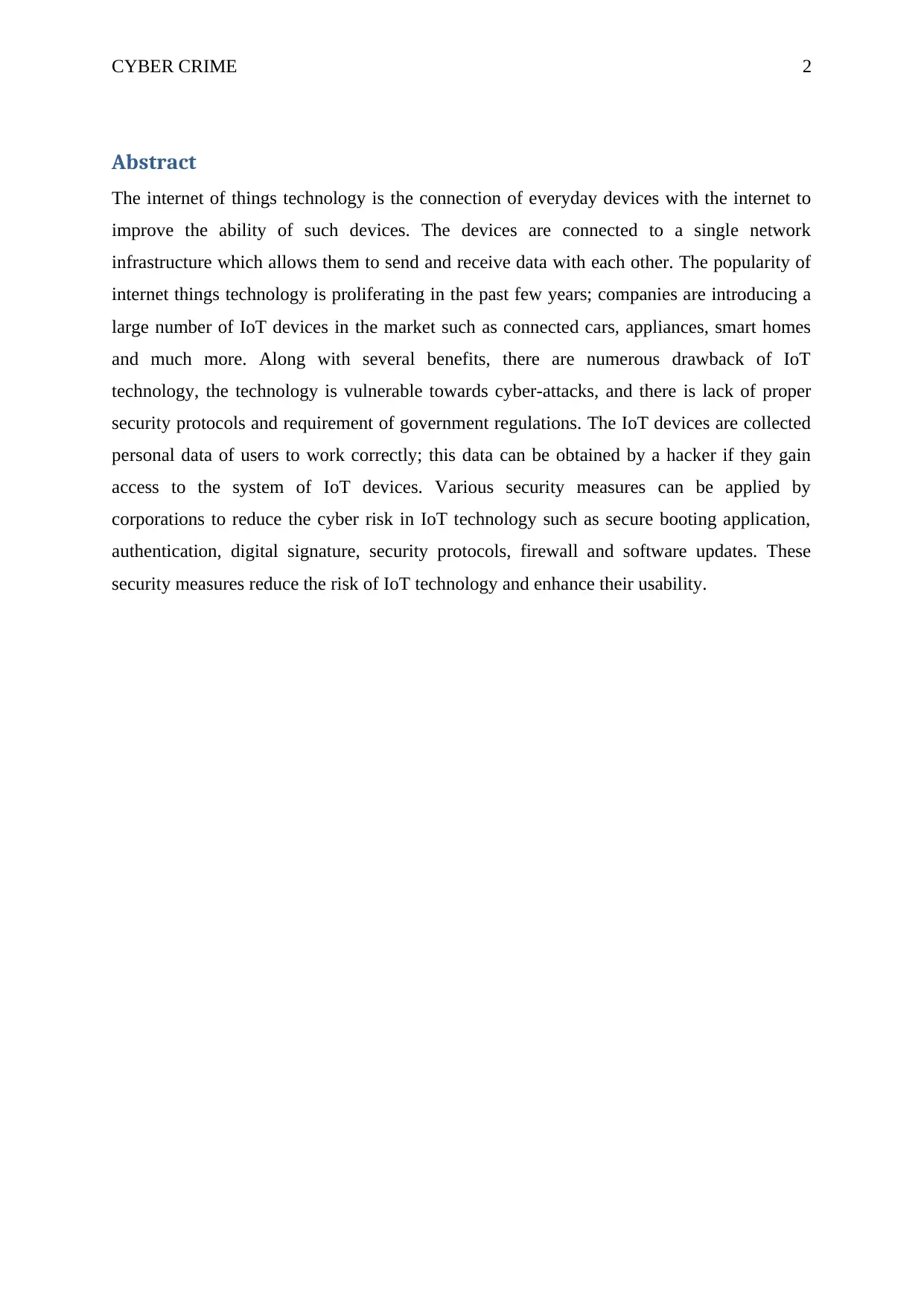
CYBER CRIME 2
Abstract
The internet of things technology is the connection of everyday devices with the internet to
improve the ability of such devices. The devices are connected to a single network
infrastructure which allows them to send and receive data with each other. The popularity of
internet things technology is proliferating in the past few years; companies are introducing a
large number of IoT devices in the market such as connected cars, appliances, smart homes
and much more. Along with several benefits, there are numerous drawback of IoT
technology, the technology is vulnerable towards cyber-attacks, and there is lack of proper
security protocols and requirement of government regulations. The IoT devices are collected
personal data of users to work correctly; this data can be obtained by a hacker if they gain
access to the system of IoT devices. Various security measures can be applied by
corporations to reduce the cyber risk in IoT technology such as secure booting application,
authentication, digital signature, security protocols, firewall and software updates. These
security measures reduce the risk of IoT technology and enhance their usability.
Abstract
The internet of things technology is the connection of everyday devices with the internet to
improve the ability of such devices. The devices are connected to a single network
infrastructure which allows them to send and receive data with each other. The popularity of
internet things technology is proliferating in the past few years; companies are introducing a
large number of IoT devices in the market such as connected cars, appliances, smart homes
and much more. Along with several benefits, there are numerous drawback of IoT
technology, the technology is vulnerable towards cyber-attacks, and there is lack of proper
security protocols and requirement of government regulations. The IoT devices are collected
personal data of users to work correctly; this data can be obtained by a hacker if they gain
access to the system of IoT devices. Various security measures can be applied by
corporations to reduce the cyber risk in IoT technology such as secure booting application,
authentication, digital signature, security protocols, firewall and software updates. These
security measures reduce the risk of IoT technology and enhance their usability.
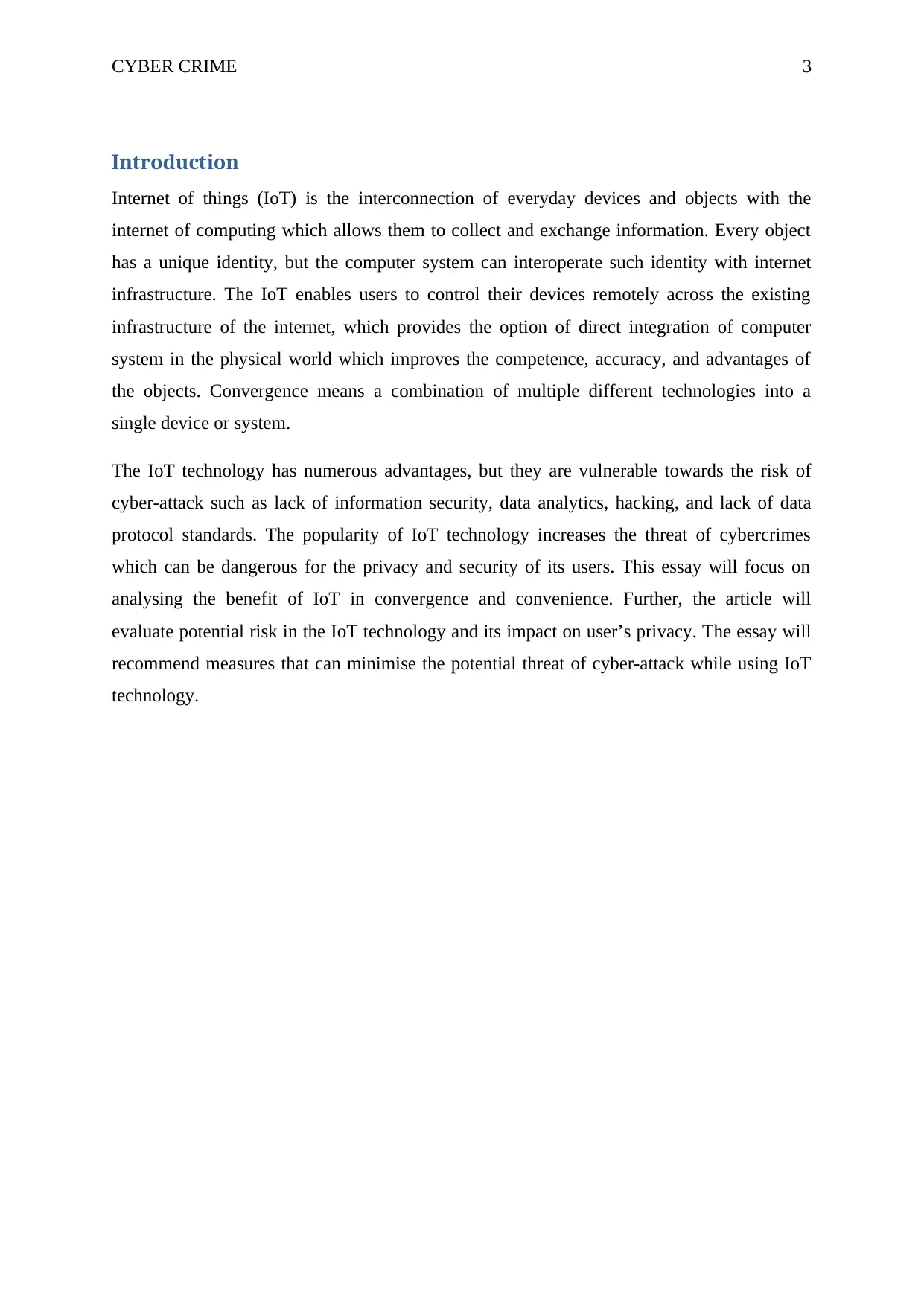
CYBER CRIME 3
Introduction
Internet of things (IoT) is the interconnection of everyday devices and objects with the
internet of computing which allows them to collect and exchange information. Every object
has a unique identity, but the computer system can interoperate such identity with internet
infrastructure. The IoT enables users to control their devices remotely across the existing
infrastructure of the internet, which provides the option of direct integration of computer
system in the physical world which improves the competence, accuracy, and advantages of
the objects. Convergence means a combination of multiple different technologies into a
single device or system.
The IoT technology has numerous advantages, but they are vulnerable towards the risk of
cyber-attack such as lack of information security, data analytics, hacking, and lack of data
protocol standards. The popularity of IoT technology increases the threat of cybercrimes
which can be dangerous for the privacy and security of its users. This essay will focus on
analysing the benefit of IoT in convergence and convenience. Further, the article will
evaluate potential risk in the IoT technology and its impact on user’s privacy. The essay will
recommend measures that can minimise the potential threat of cyber-attack while using IoT
technology.
Introduction
Internet of things (IoT) is the interconnection of everyday devices and objects with the
internet of computing which allows them to collect and exchange information. Every object
has a unique identity, but the computer system can interoperate such identity with internet
infrastructure. The IoT enables users to control their devices remotely across the existing
infrastructure of the internet, which provides the option of direct integration of computer
system in the physical world which improves the competence, accuracy, and advantages of
the objects. Convergence means a combination of multiple different technologies into a
single device or system.
The IoT technology has numerous advantages, but they are vulnerable towards the risk of
cyber-attack such as lack of information security, data analytics, hacking, and lack of data
protocol standards. The popularity of IoT technology increases the threat of cybercrimes
which can be dangerous for the privacy and security of its users. This essay will focus on
analysing the benefit of IoT in convergence and convenience. Further, the article will
evaluate potential risk in the IoT technology and its impact on user’s privacy. The essay will
recommend measures that can minimise the potential threat of cyber-attack while using IoT
technology.
Secure Best Marks with AI Grader
Need help grading? Try our AI Grader for instant feedback on your assignments.
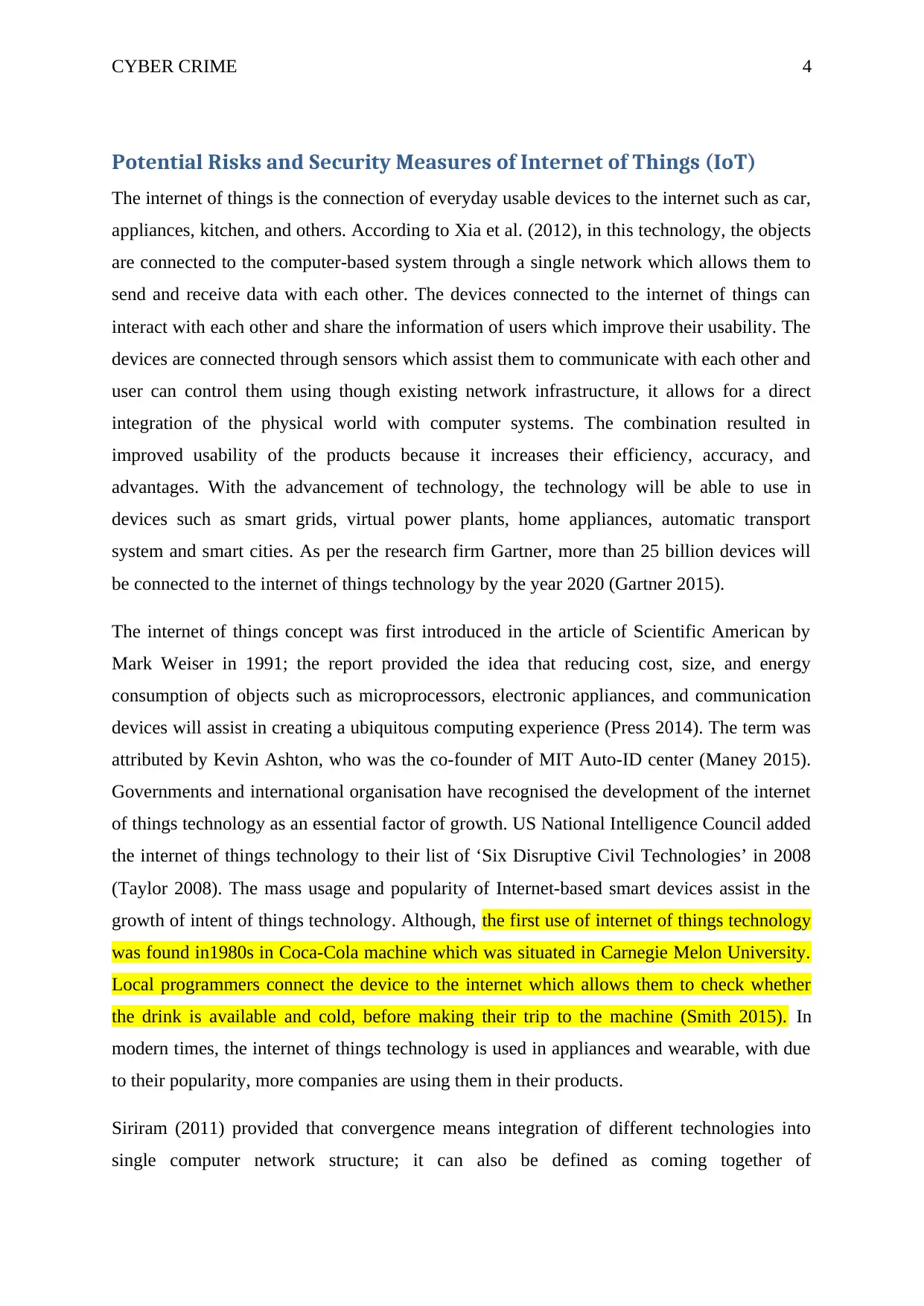
CYBER CRIME 4
Potential Risks and Security Measures of Internet of Things (IoT)
The internet of things is the connection of everyday usable devices to the internet such as car,
appliances, kitchen, and others. According to Xia et al. (2012), in this technology, the objects
are connected to the computer-based system through a single network which allows them to
send and receive data with each other. The devices connected to the internet of things can
interact with each other and share the information of users which improve their usability. The
devices are connected through sensors which assist them to communicate with each other and
user can control them using though existing network infrastructure, it allows for a direct
integration of the physical world with computer systems. The combination resulted in
improved usability of the products because it increases their efficiency, accuracy, and
advantages. With the advancement of technology, the technology will be able to use in
devices such as smart grids, virtual power plants, home appliances, automatic transport
system and smart cities. As per the research firm Gartner, more than 25 billion devices will
be connected to the internet of things technology by the year 2020 (Gartner 2015).
The internet of things concept was first introduced in the article of Scientific American by
Mark Weiser in 1991; the report provided the idea that reducing cost, size, and energy
consumption of objects such as microprocessors, electronic appliances, and communication
devices will assist in creating a ubiquitous computing experience (Press 2014). The term was
attributed by Kevin Ashton, who was the co-founder of MIT Auto-ID center (Maney 2015).
Governments and international organisation have recognised the development of the internet
of things technology as an essential factor of growth. US National Intelligence Council added
the internet of things technology to their list of ‘Six Disruptive Civil Technologies’ in 2008
(Taylor 2008). The mass usage and popularity of Internet-based smart devices assist in the
growth of intent of things technology. Although, the first use of internet of things technology
was found in1980s in Coca-Cola machine which was situated in Carnegie Melon University.
Local programmers connect the device to the internet which allows them to check whether
the drink is available and cold, before making their trip to the machine (Smith 2015). In
modern times, the internet of things technology is used in appliances and wearable, with due
to their popularity, more companies are using them in their products.
Siriram (2011) provided that convergence means integration of different technologies into
single computer network structure; it can also be defined as coming together of
Potential Risks and Security Measures of Internet of Things (IoT)
The internet of things is the connection of everyday usable devices to the internet such as car,
appliances, kitchen, and others. According to Xia et al. (2012), in this technology, the objects
are connected to the computer-based system through a single network which allows them to
send and receive data with each other. The devices connected to the internet of things can
interact with each other and share the information of users which improve their usability. The
devices are connected through sensors which assist them to communicate with each other and
user can control them using though existing network infrastructure, it allows for a direct
integration of the physical world with computer systems. The combination resulted in
improved usability of the products because it increases their efficiency, accuracy, and
advantages. With the advancement of technology, the technology will be able to use in
devices such as smart grids, virtual power plants, home appliances, automatic transport
system and smart cities. As per the research firm Gartner, more than 25 billion devices will
be connected to the internet of things technology by the year 2020 (Gartner 2015).
The internet of things concept was first introduced in the article of Scientific American by
Mark Weiser in 1991; the report provided the idea that reducing cost, size, and energy
consumption of objects such as microprocessors, electronic appliances, and communication
devices will assist in creating a ubiquitous computing experience (Press 2014). The term was
attributed by Kevin Ashton, who was the co-founder of MIT Auto-ID center (Maney 2015).
Governments and international organisation have recognised the development of the internet
of things technology as an essential factor of growth. US National Intelligence Council added
the internet of things technology to their list of ‘Six Disruptive Civil Technologies’ in 2008
(Taylor 2008). The mass usage and popularity of Internet-based smart devices assist in the
growth of intent of things technology. Although, the first use of internet of things technology
was found in1980s in Coca-Cola machine which was situated in Carnegie Melon University.
Local programmers connect the device to the internet which allows them to check whether
the drink is available and cold, before making their trip to the machine (Smith 2015). In
modern times, the internet of things technology is used in appliances and wearable, with due
to their popularity, more companies are using them in their products.
Siriram (2011) provided that convergence means integration of different technologies into
single computer network structure; it can also be defined as coming together of
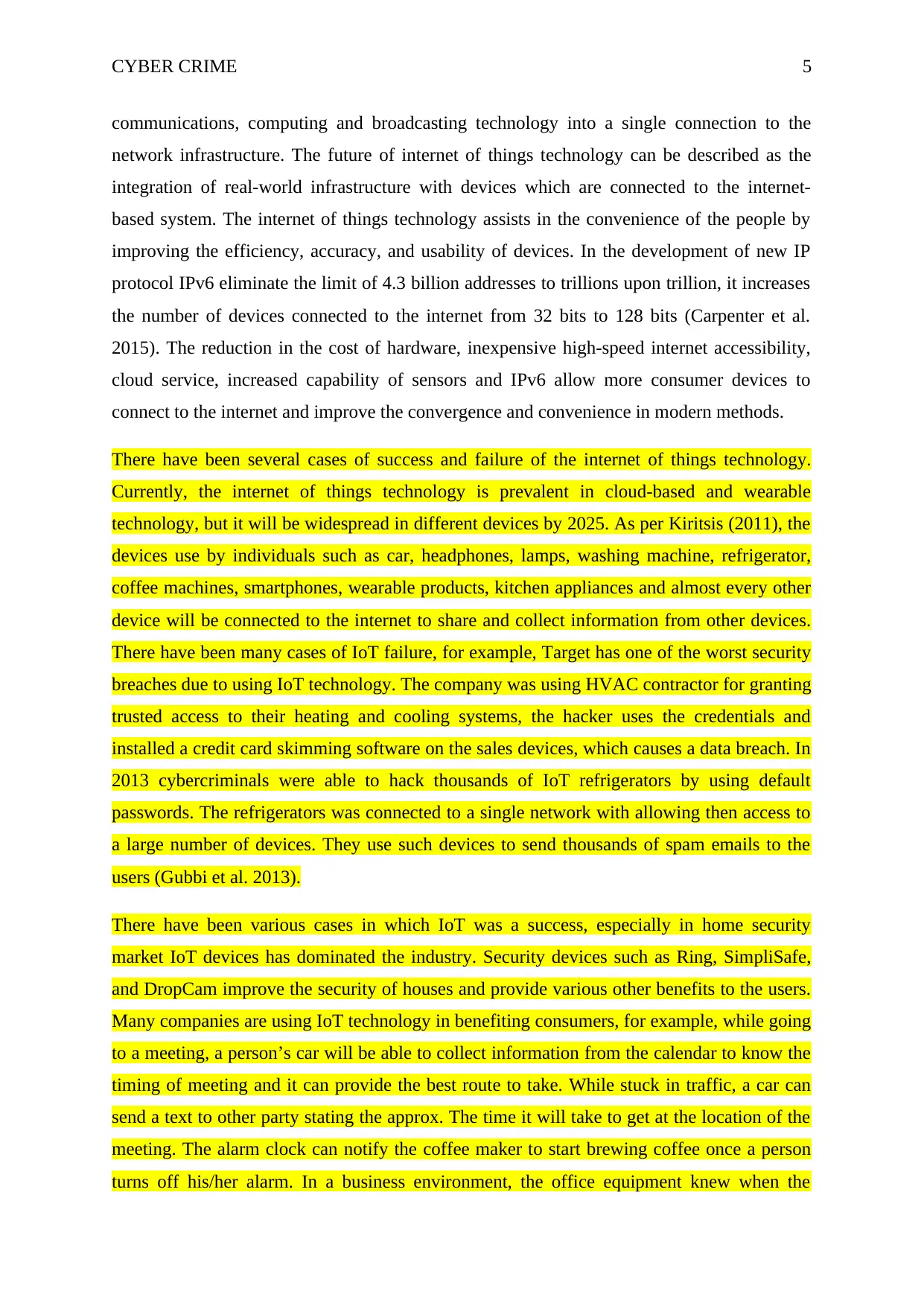
CYBER CRIME 5
communications, computing and broadcasting technology into a single connection to the
network infrastructure. The future of internet of things technology can be described as the
integration of real-world infrastructure with devices which are connected to the internet-
based system. The internet of things technology assists in the convenience of the people by
improving the efficiency, accuracy, and usability of devices. In the development of new IP
protocol IPv6 eliminate the limit of 4.3 billion addresses to trillions upon trillion, it increases
the number of devices connected to the internet from 32 bits to 128 bits (Carpenter et al.
2015). The reduction in the cost of hardware, inexpensive high-speed internet accessibility,
cloud service, increased capability of sensors and IPv6 allow more consumer devices to
connect to the internet and improve the convergence and convenience in modern methods.
There have been several cases of success and failure of the internet of things technology.
Currently, the internet of things technology is prevalent in cloud-based and wearable
technology, but it will be widespread in different devices by 2025. As per Kiritsis (2011), the
devices use by individuals such as car, headphones, lamps, washing machine, refrigerator,
coffee machines, smartphones, wearable products, kitchen appliances and almost every other
device will be connected to the internet to share and collect information from other devices.
There have been many cases of IoT failure, for example, Target has one of the worst security
breaches due to using IoT technology. The company was using HVAC contractor for granting
trusted access to their heating and cooling systems, the hacker uses the credentials and
installed a credit card skimming software on the sales devices, which causes a data breach. In
2013 cybercriminals were able to hack thousands of IoT refrigerators by using default
passwords. The refrigerators was connected to a single network with allowing then access to
a large number of devices. They use such devices to send thousands of spam emails to the
users (Gubbi et al. 2013).
There have been various cases in which IoT was a success, especially in home security
market IoT devices has dominated the industry. Security devices such as Ring, SimpliSafe,
and DropCam improve the security of houses and provide various other benefits to the users.
Many companies are using IoT technology in benefiting consumers, for example, while going
to a meeting, a person’s car will be able to collect information from the calendar to know the
timing of meeting and it can provide the best route to take. While stuck in traffic, a car can
send a text to other party stating the approx. The time it will take to get at the location of the
meeting. The alarm clock can notify the coffee maker to start brewing coffee once a person
turns off his/her alarm. In a business environment, the office equipment knew when the
communications, computing and broadcasting technology into a single connection to the
network infrastructure. The future of internet of things technology can be described as the
integration of real-world infrastructure with devices which are connected to the internet-
based system. The internet of things technology assists in the convenience of the people by
improving the efficiency, accuracy, and usability of devices. In the development of new IP
protocol IPv6 eliminate the limit of 4.3 billion addresses to trillions upon trillion, it increases
the number of devices connected to the internet from 32 bits to 128 bits (Carpenter et al.
2015). The reduction in the cost of hardware, inexpensive high-speed internet accessibility,
cloud service, increased capability of sensors and IPv6 allow more consumer devices to
connect to the internet and improve the convergence and convenience in modern methods.
There have been several cases of success and failure of the internet of things technology.
Currently, the internet of things technology is prevalent in cloud-based and wearable
technology, but it will be widespread in different devices by 2025. As per Kiritsis (2011), the
devices use by individuals such as car, headphones, lamps, washing machine, refrigerator,
coffee machines, smartphones, wearable products, kitchen appliances and almost every other
device will be connected to the internet to share and collect information from other devices.
There have been many cases of IoT failure, for example, Target has one of the worst security
breaches due to using IoT technology. The company was using HVAC contractor for granting
trusted access to their heating and cooling systems, the hacker uses the credentials and
installed a credit card skimming software on the sales devices, which causes a data breach. In
2013 cybercriminals were able to hack thousands of IoT refrigerators by using default
passwords. The refrigerators was connected to a single network with allowing then access to
a large number of devices. They use such devices to send thousands of spam emails to the
users (Gubbi et al. 2013).
There have been various cases in which IoT was a success, especially in home security
market IoT devices has dominated the industry. Security devices such as Ring, SimpliSafe,
and DropCam improve the security of houses and provide various other benefits to the users.
Many companies are using IoT technology in benefiting consumers, for example, while going
to a meeting, a person’s car will be able to collect information from the calendar to know the
timing of meeting and it can provide the best route to take. While stuck in traffic, a car can
send a text to other party stating the approx. The time it will take to get at the location of the
meeting. The alarm clock can notify the coffee maker to start brewing coffee once a person
turns off his/her alarm. In a business environment, the office equipment knew when the
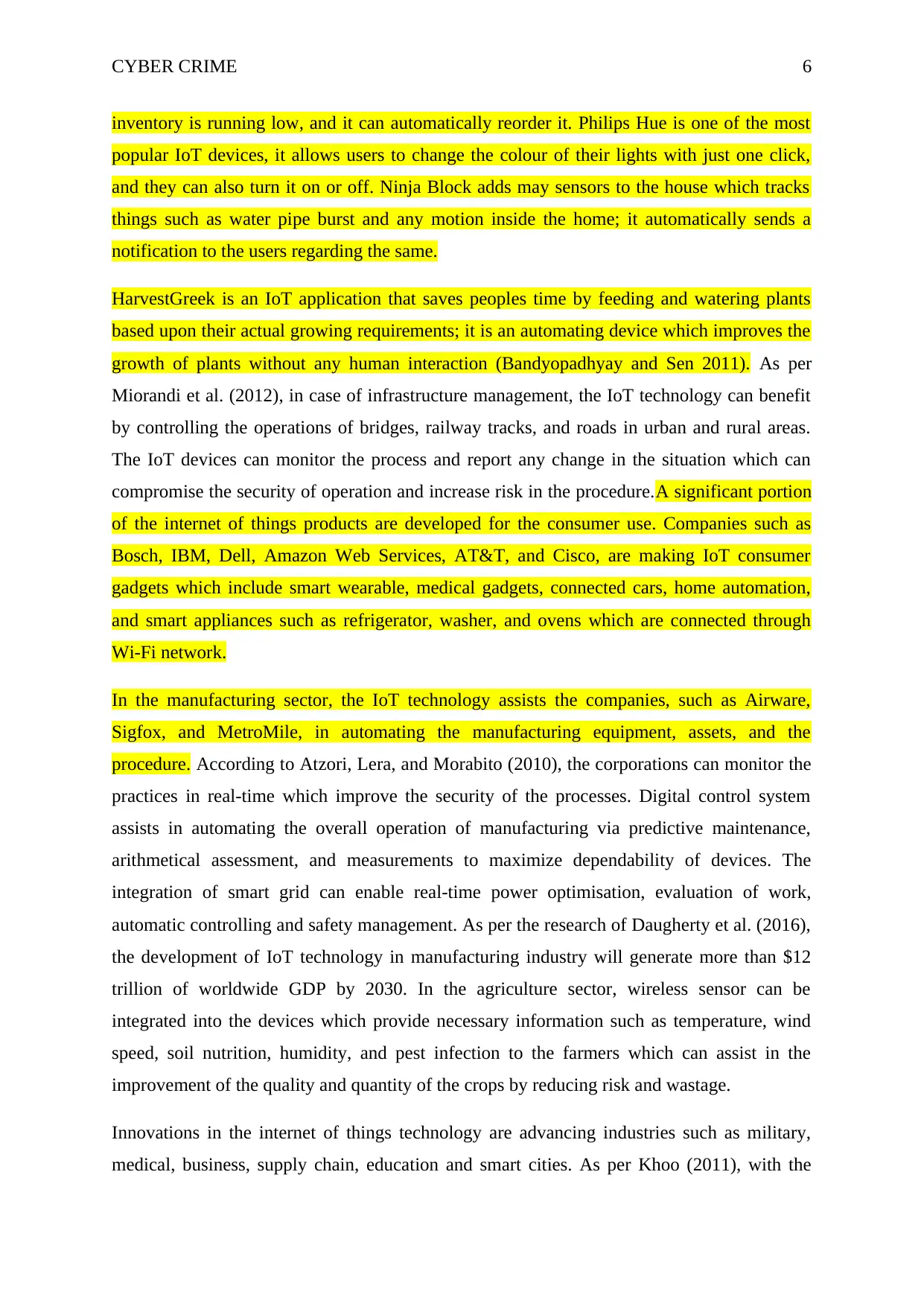
CYBER CRIME 6
inventory is running low, and it can automatically reorder it. Philips Hue is one of the most
popular IoT devices, it allows users to change the colour of their lights with just one click,
and they can also turn it on or off. Ninja Block adds may sensors to the house which tracks
things such as water pipe burst and any motion inside the home; it automatically sends a
notification to the users regarding the same.
HarvestGreek is an IoT application that saves peoples time by feeding and watering plants
based upon their actual growing requirements; it is an automating device which improves the
growth of plants without any human interaction (Bandyopadhyay and Sen 2011). As per
Miorandi et al. (2012), in case of infrastructure management, the IoT technology can benefit
by controlling the operations of bridges, railway tracks, and roads in urban and rural areas.
The IoT devices can monitor the process and report any change in the situation which can
compromise the security of operation and increase risk in the procedure.A significant portion
of the internet of things products are developed for the consumer use. Companies such as
Bosch, IBM, Dell, Amazon Web Services, AT&T, and Cisco, are making IoT consumer
gadgets which include smart wearable, medical gadgets, connected cars, home automation,
and smart appliances such as refrigerator, washer, and ovens which are connected through
Wi-Fi network.
In the manufacturing sector, the IoT technology assists the companies, such as Airware,
Sigfox, and MetroMile, in automating the manufacturing equipment, assets, and the
procedure. According to Atzori, Lera, and Morabito (2010), the corporations can monitor the
practices in real-time which improve the security of the processes. Digital control system
assists in automating the overall operation of manufacturing via predictive maintenance,
arithmetical assessment, and measurements to maximize dependability of devices. The
integration of smart grid can enable real-time power optimisation, evaluation of work,
automatic controlling and safety management. As per the research of Daugherty et al. (2016),
the development of IoT technology in manufacturing industry will generate more than $12
trillion of worldwide GDP by 2030. In the agriculture sector, wireless sensor can be
integrated into the devices which provide necessary information such as temperature, wind
speed, soil nutrition, humidity, and pest infection to the farmers which can assist in the
improvement of the quality and quantity of the crops by reducing risk and wastage.
Innovations in the internet of things technology are advancing industries such as military,
medical, business, supply chain, education and smart cities. As per Khoo (2011), with the
inventory is running low, and it can automatically reorder it. Philips Hue is one of the most
popular IoT devices, it allows users to change the colour of their lights with just one click,
and they can also turn it on or off. Ninja Block adds may sensors to the house which tracks
things such as water pipe burst and any motion inside the home; it automatically sends a
notification to the users regarding the same.
HarvestGreek is an IoT application that saves peoples time by feeding and watering plants
based upon their actual growing requirements; it is an automating device which improves the
growth of plants without any human interaction (Bandyopadhyay and Sen 2011). As per
Miorandi et al. (2012), in case of infrastructure management, the IoT technology can benefit
by controlling the operations of bridges, railway tracks, and roads in urban and rural areas.
The IoT devices can monitor the process and report any change in the situation which can
compromise the security of operation and increase risk in the procedure.A significant portion
of the internet of things products are developed for the consumer use. Companies such as
Bosch, IBM, Dell, Amazon Web Services, AT&T, and Cisco, are making IoT consumer
gadgets which include smart wearable, medical gadgets, connected cars, home automation,
and smart appliances such as refrigerator, washer, and ovens which are connected through
Wi-Fi network.
In the manufacturing sector, the IoT technology assists the companies, such as Airware,
Sigfox, and MetroMile, in automating the manufacturing equipment, assets, and the
procedure. According to Atzori, Lera, and Morabito (2010), the corporations can monitor the
practices in real-time which improve the security of the processes. Digital control system
assists in automating the overall operation of manufacturing via predictive maintenance,
arithmetical assessment, and measurements to maximize dependability of devices. The
integration of smart grid can enable real-time power optimisation, evaluation of work,
automatic controlling and safety management. As per the research of Daugherty et al. (2016),
the development of IoT technology in manufacturing industry will generate more than $12
trillion of worldwide GDP by 2030. In the agriculture sector, wireless sensor can be
integrated into the devices which provide necessary information such as temperature, wind
speed, soil nutrition, humidity, and pest infection to the farmers which can assist in the
improvement of the quality and quantity of the crops by reducing risk and wastage.
Innovations in the internet of things technology are advancing industries such as military,
medical, business, supply chain, education and smart cities. As per Khoo (2011), with the
Paraphrase This Document
Need a fresh take? Get an instant paraphrase of this document with our AI Paraphraser
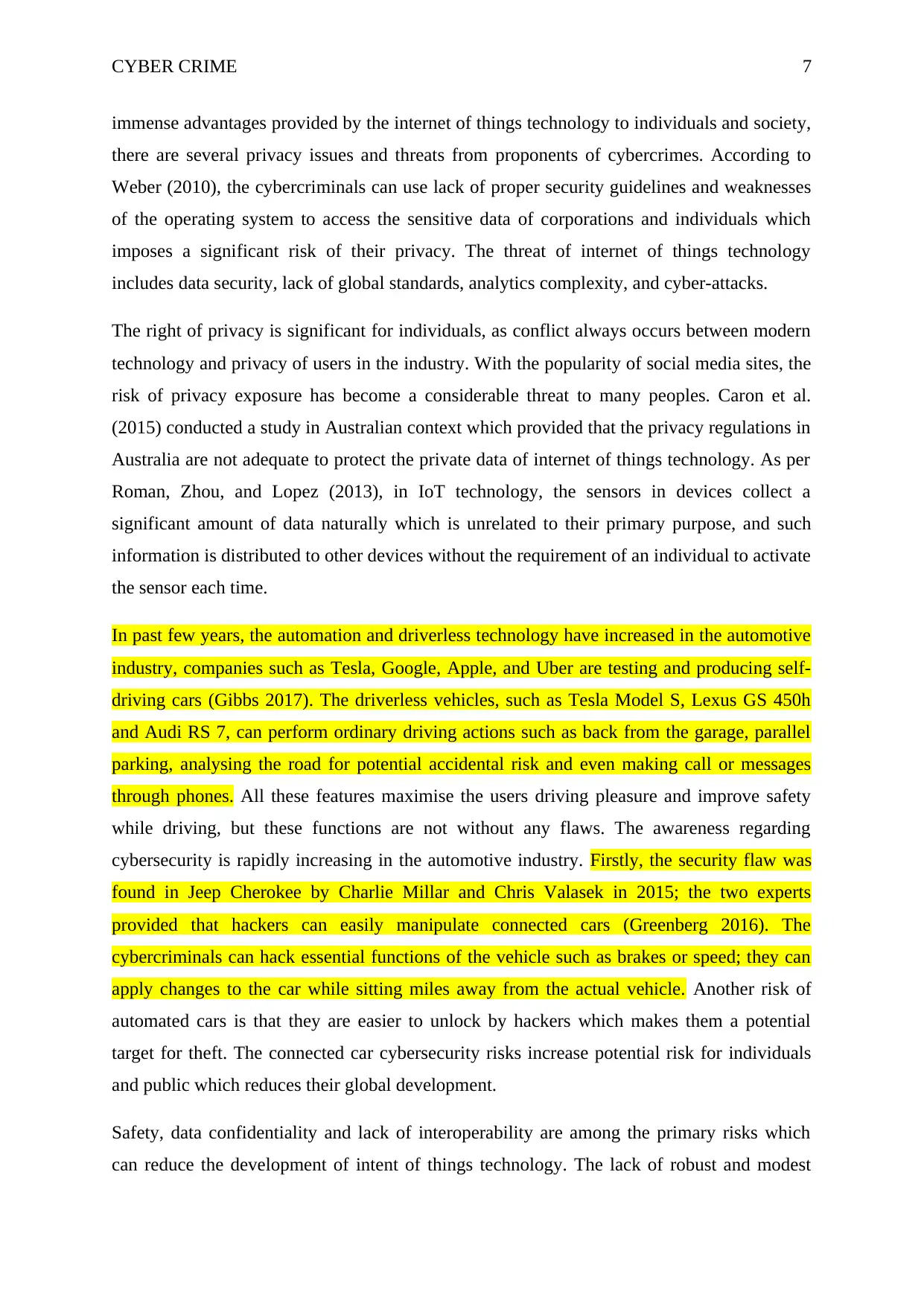
CYBER CRIME 7
immense advantages provided by the internet of things technology to individuals and society,
there are several privacy issues and threats from proponents of cybercrimes. According to
Weber (2010), the cybercriminals can use lack of proper security guidelines and weaknesses
of the operating system to access the sensitive data of corporations and individuals which
imposes a significant risk of their privacy. The threat of internet of things technology
includes data security, lack of global standards, analytics complexity, and cyber-attacks.
The right of privacy is significant for individuals, as conflict always occurs between modern
technology and privacy of users in the industry. With the popularity of social media sites, the
risk of privacy exposure has become a considerable threat to many peoples. Caron et al.
(2015) conducted a study in Australian context which provided that the privacy regulations in
Australia are not adequate to protect the private data of internet of things technology. As per
Roman, Zhou, and Lopez (2013), in IoT technology, the sensors in devices collect a
significant amount of data naturally which is unrelated to their primary purpose, and such
information is distributed to other devices without the requirement of an individual to activate
the sensor each time.
In past few years, the automation and driverless technology have increased in the automotive
industry, companies such as Tesla, Google, Apple, and Uber are testing and producing self-
driving cars (Gibbs 2017). The driverless vehicles, such as Tesla Model S, Lexus GS 450h
and Audi RS 7, can perform ordinary driving actions such as back from the garage, parallel
parking, analysing the road for potential accidental risk and even making call or messages
through phones. All these features maximise the users driving pleasure and improve safety
while driving, but these functions are not without any flaws. The awareness regarding
cybersecurity is rapidly increasing in the automotive industry. Firstly, the security flaw was
found in Jeep Cherokee by Charlie Millar and Chris Valasek in 2015; the two experts
provided that hackers can easily manipulate connected cars (Greenberg 2016). The
cybercriminals can hack essential functions of the vehicle such as brakes or speed; they can
apply changes to the car while sitting miles away from the actual vehicle. Another risk of
automated cars is that they are easier to unlock by hackers which makes them a potential
target for theft. The connected car cybersecurity risks increase potential risk for individuals
and public which reduces their global development.
Safety, data confidentiality and lack of interoperability are among the primary risks which
can reduce the development of intent of things technology. The lack of robust and modest
immense advantages provided by the internet of things technology to individuals and society,
there are several privacy issues and threats from proponents of cybercrimes. According to
Weber (2010), the cybercriminals can use lack of proper security guidelines and weaknesses
of the operating system to access the sensitive data of corporations and individuals which
imposes a significant risk of their privacy. The threat of internet of things technology
includes data security, lack of global standards, analytics complexity, and cyber-attacks.
The right of privacy is significant for individuals, as conflict always occurs between modern
technology and privacy of users in the industry. With the popularity of social media sites, the
risk of privacy exposure has become a considerable threat to many peoples. Caron et al.
(2015) conducted a study in Australian context which provided that the privacy regulations in
Australia are not adequate to protect the private data of internet of things technology. As per
Roman, Zhou, and Lopez (2013), in IoT technology, the sensors in devices collect a
significant amount of data naturally which is unrelated to their primary purpose, and such
information is distributed to other devices without the requirement of an individual to activate
the sensor each time.
In past few years, the automation and driverless technology have increased in the automotive
industry, companies such as Tesla, Google, Apple, and Uber are testing and producing self-
driving cars (Gibbs 2017). The driverless vehicles, such as Tesla Model S, Lexus GS 450h
and Audi RS 7, can perform ordinary driving actions such as back from the garage, parallel
parking, analysing the road for potential accidental risk and even making call or messages
through phones. All these features maximise the users driving pleasure and improve safety
while driving, but these functions are not without any flaws. The awareness regarding
cybersecurity is rapidly increasing in the automotive industry. Firstly, the security flaw was
found in Jeep Cherokee by Charlie Millar and Chris Valasek in 2015; the two experts
provided that hackers can easily manipulate connected cars (Greenberg 2016). The
cybercriminals can hack essential functions of the vehicle such as brakes or speed; they can
apply changes to the car while sitting miles away from the actual vehicle. Another risk of
automated cars is that they are easier to unlock by hackers which makes them a potential
target for theft. The connected car cybersecurity risks increase potential risk for individuals
and public which reduces their global development.
Safety, data confidentiality and lack of interoperability are among the primary risks which
can reduce the development of intent of things technology. The lack of robust and modest
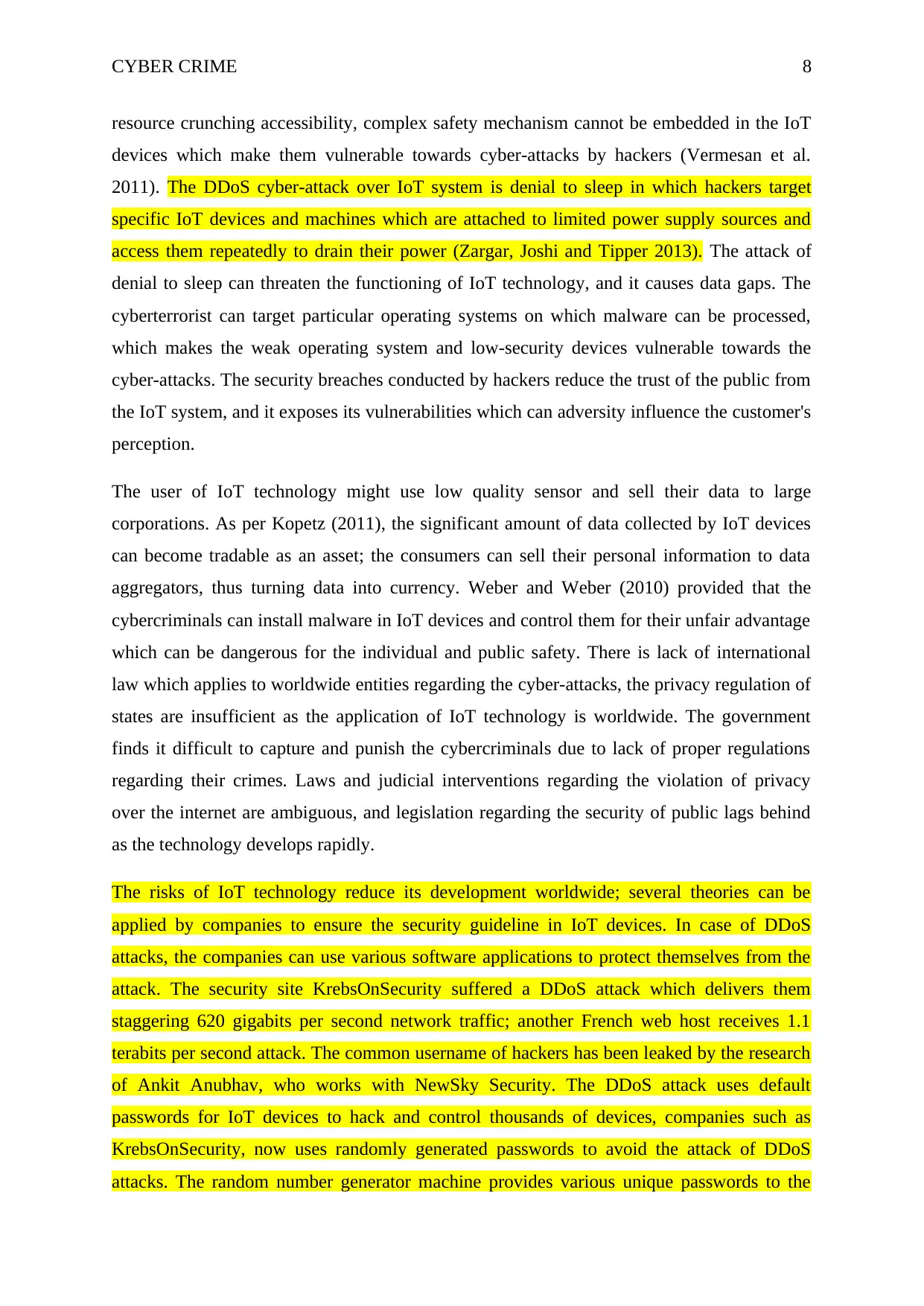
CYBER CRIME 8
resource crunching accessibility, complex safety mechanism cannot be embedded in the IoT
devices which make them vulnerable towards cyber-attacks by hackers (Vermesan et al.
2011). The DDoS cyber-attack over IoT system is denial to sleep in which hackers target
specific IoT devices and machines which are attached to limited power supply sources and
access them repeatedly to drain their power (Zargar, Joshi and Tipper 2013). The attack of
denial to sleep can threaten the functioning of IoT technology, and it causes data gaps. The
cyberterrorist can target particular operating systems on which malware can be processed,
which makes the weak operating system and low-security devices vulnerable towards the
cyber-attacks. The security breaches conducted by hackers reduce the trust of the public from
the IoT system, and it exposes its vulnerabilities which can adversity influence the customer's
perception.
The user of IoT technology might use low quality sensor and sell their data to large
corporations. As per Kopetz (2011), the significant amount of data collected by IoT devices
can become tradable as an asset; the consumers can sell their personal information to data
aggregators, thus turning data into currency. Weber and Weber (2010) provided that the
cybercriminals can install malware in IoT devices and control them for their unfair advantage
which can be dangerous for the individual and public safety. There is lack of international
law which applies to worldwide entities regarding the cyber-attacks, the privacy regulation of
states are insufficient as the application of IoT technology is worldwide. The government
finds it difficult to capture and punish the cybercriminals due to lack of proper regulations
regarding their crimes. Laws and judicial interventions regarding the violation of privacy
over the internet are ambiguous, and legislation regarding the security of public lags behind
as the technology develops rapidly.
The risks of IoT technology reduce its development worldwide; several theories can be
applied by companies to ensure the security guideline in IoT devices. In case of DDoS
attacks, the companies can use various software applications to protect themselves from the
attack. The security site KrebsOnSecurity suffered a DDoS attack which delivers them
staggering 620 gigabits per second network traffic; another French web host receives 1.1
terabits per second attack. The common username of hackers has been leaked by the research
of Ankit Anubhav, who works with NewSky Security. The DDoS attack uses default
passwords for IoT devices to hack and control thousands of devices, companies such as
KrebsOnSecurity, now uses randomly generated passwords to avoid the attack of DDoS
attacks. The random number generator machine provides various unique passwords to the
resource crunching accessibility, complex safety mechanism cannot be embedded in the IoT
devices which make them vulnerable towards cyber-attacks by hackers (Vermesan et al.
2011). The DDoS cyber-attack over IoT system is denial to sleep in which hackers target
specific IoT devices and machines which are attached to limited power supply sources and
access them repeatedly to drain their power (Zargar, Joshi and Tipper 2013). The attack of
denial to sleep can threaten the functioning of IoT technology, and it causes data gaps. The
cyberterrorist can target particular operating systems on which malware can be processed,
which makes the weak operating system and low-security devices vulnerable towards the
cyber-attacks. The security breaches conducted by hackers reduce the trust of the public from
the IoT system, and it exposes its vulnerabilities which can adversity influence the customer's
perception.
The user of IoT technology might use low quality sensor and sell their data to large
corporations. As per Kopetz (2011), the significant amount of data collected by IoT devices
can become tradable as an asset; the consumers can sell their personal information to data
aggregators, thus turning data into currency. Weber and Weber (2010) provided that the
cybercriminals can install malware in IoT devices and control them for their unfair advantage
which can be dangerous for the individual and public safety. There is lack of international
law which applies to worldwide entities regarding the cyber-attacks, the privacy regulation of
states are insufficient as the application of IoT technology is worldwide. The government
finds it difficult to capture and punish the cybercriminals due to lack of proper regulations
regarding their crimes. Laws and judicial interventions regarding the violation of privacy
over the internet are ambiguous, and legislation regarding the security of public lags behind
as the technology develops rapidly.
The risks of IoT technology reduce its development worldwide; several theories can be
applied by companies to ensure the security guideline in IoT devices. In case of DDoS
attacks, the companies can use various software applications to protect themselves from the
attack. The security site KrebsOnSecurity suffered a DDoS attack which delivers them
staggering 620 gigabits per second network traffic; another French web host receives 1.1
terabits per second attack. The common username of hackers has been leaked by the research
of Ankit Anubhav, who works with NewSky Security. The DDoS attack uses default
passwords for IoT devices to hack and control thousands of devices, companies such as
KrebsOnSecurity, now uses randomly generated passwords to avoid the attack of DDoS
attacks. The random number generator machine provides various unique passwords to the

CYBER CRIME 9
businesses which they can use to protect the IoT devices, by using this method, IoT devices
working on same networks will be protected from cyber-attack.
Another theory that can be applied by companies to protect IoT devices of people from year
attacks is “Nudge Theory”. According to Yang (2014), this theory focuses on changing the
behaviour of individuals by “nudging” them towards better security decisions. For example,
Facebook privacy nudge prevented users from unintentionally disclosing things which they
might regret in future, such as a nasty comment or personal details. The users should
continuously change their IoT devices passwords, and the passwords must be unique and
difficult to ensure a high level of protection. The IoT devices should be continuously updated
because companies can provide new security against malware in updates. The corporations
and industry can apply various measures to protect the IoT technology from cybercriminals.
As per Wortmann and Fluchter (2015), while decentralising the data, such as cloud service,
procedure, gadgets and corporate bodies, it is necessary that such integration is systematic to
provide safety to the data. IoT technology requires real-time interoperability in the devices
and security measures need to adapt and prevent data islands. Encryption of data is necessary
while implementing an IoT technology while transmitting the data through different IoT
gadgets it is necessary that such information is not leaked in the process.
Suo et al. (2012) provided that encryption algorithm turns standard text into cipher text which
makes it difficult for hackers to understand the data; it ensures the security of information
while it transfers between different internets of things devices such as refrigerator, air
conditioners, and lights. The encryption procedure is significantly crucial while using smart
homes devices because these gadgets continuously send and receive information with each
other, and breach in one device can compromise the security of the entire system. Another
method is hash-based cryptography theory which uses a digital signature scheme to secure
the data of users. This theory ensures that while sharing the information, IoT devices decide
whether an application can be trusted or not. Therefore, the proper authentication credentials
are required to enter by an application to connect and share with IoT gadgets. As per
Vlacheas et al. (2013), there is a considerable lack of identity and access management tools in
authentication framework of IoT gateways. The implementation of global structures for
authentication will be difficult to establish because solutions are created for the traditional
environment, and they did not apply to the varied, heterogeneous and dispersed environment
of IoT.
businesses which they can use to protect the IoT devices, by using this method, IoT devices
working on same networks will be protected from cyber-attack.
Another theory that can be applied by companies to protect IoT devices of people from year
attacks is “Nudge Theory”. According to Yang (2014), this theory focuses on changing the
behaviour of individuals by “nudging” them towards better security decisions. For example,
Facebook privacy nudge prevented users from unintentionally disclosing things which they
might regret in future, such as a nasty comment or personal details. The users should
continuously change their IoT devices passwords, and the passwords must be unique and
difficult to ensure a high level of protection. The IoT devices should be continuously updated
because companies can provide new security against malware in updates. The corporations
and industry can apply various measures to protect the IoT technology from cybercriminals.
As per Wortmann and Fluchter (2015), while decentralising the data, such as cloud service,
procedure, gadgets and corporate bodies, it is necessary that such integration is systematic to
provide safety to the data. IoT technology requires real-time interoperability in the devices
and security measures need to adapt and prevent data islands. Encryption of data is necessary
while implementing an IoT technology while transmitting the data through different IoT
gadgets it is necessary that such information is not leaked in the process.
Suo et al. (2012) provided that encryption algorithm turns standard text into cipher text which
makes it difficult for hackers to understand the data; it ensures the security of information
while it transfers between different internets of things devices such as refrigerator, air
conditioners, and lights. The encryption procedure is significantly crucial while using smart
homes devices because these gadgets continuously send and receive information with each
other, and breach in one device can compromise the security of the entire system. Another
method is hash-based cryptography theory which uses a digital signature scheme to secure
the data of users. This theory ensures that while sharing the information, IoT devices decide
whether an application can be trusted or not. Therefore, the proper authentication credentials
are required to enter by an application to connect and share with IoT gadgets. As per
Vlacheas et al. (2013), there is a considerable lack of identity and access management tools in
authentication framework of IoT gateways. The implementation of global structures for
authentication will be difficult to establish because solutions are created for the traditional
environment, and they did not apply to the varied, heterogeneous and dispersed environment
of IoT.
Secure Best Marks with AI Grader
Need help grading? Try our AI Grader for instant feedback on your assignments.
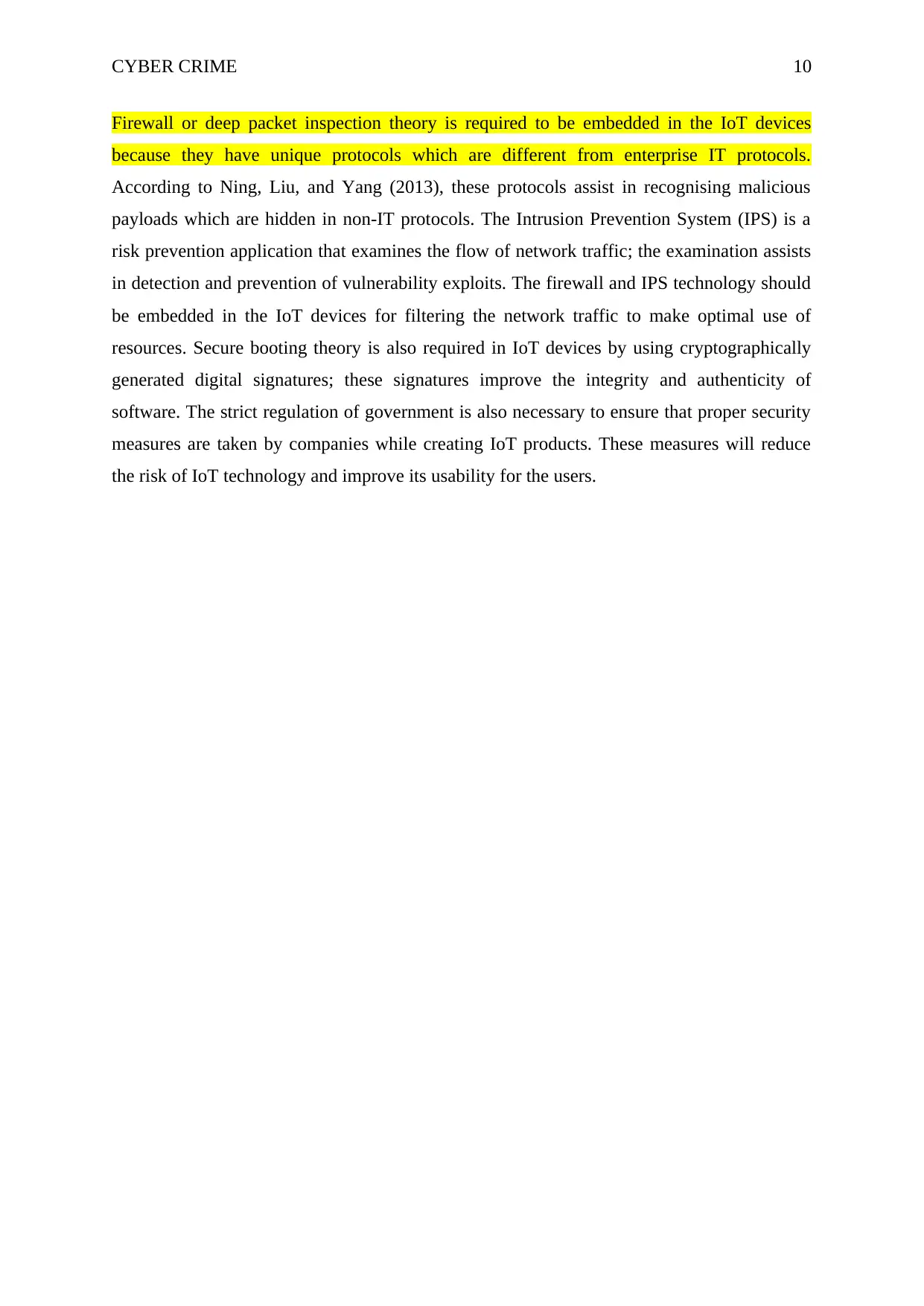
CYBER CRIME 10
Firewall or deep packet inspection theory is required to be embedded in the IoT devices
because they have unique protocols which are different from enterprise IT protocols.
According to Ning, Liu, and Yang (2013), these protocols assist in recognising malicious
payloads which are hidden in non-IT protocols. The Intrusion Prevention System (IPS) is a
risk prevention application that examines the flow of network traffic; the examination assists
in detection and prevention of vulnerability exploits. The firewall and IPS technology should
be embedded in the IoT devices for filtering the network traffic to make optimal use of
resources. Secure booting theory is also required in IoT devices by using cryptographically
generated digital signatures; these signatures improve the integrity and authenticity of
software. The strict regulation of government is also necessary to ensure that proper security
measures are taken by companies while creating IoT products. These measures will reduce
the risk of IoT technology and improve its usability for the users.
Firewall or deep packet inspection theory is required to be embedded in the IoT devices
because they have unique protocols which are different from enterprise IT protocols.
According to Ning, Liu, and Yang (2013), these protocols assist in recognising malicious
payloads which are hidden in non-IT protocols. The Intrusion Prevention System (IPS) is a
risk prevention application that examines the flow of network traffic; the examination assists
in detection and prevention of vulnerability exploits. The firewall and IPS technology should
be embedded in the IoT devices for filtering the network traffic to make optimal use of
resources. Secure booting theory is also required in IoT devices by using cryptographically
generated digital signatures; these signatures improve the integrity and authenticity of
software. The strict regulation of government is also necessary to ensure that proper security
measures are taken by companies while creating IoT products. These measures will reduce
the risk of IoT technology and improve its usability for the users.
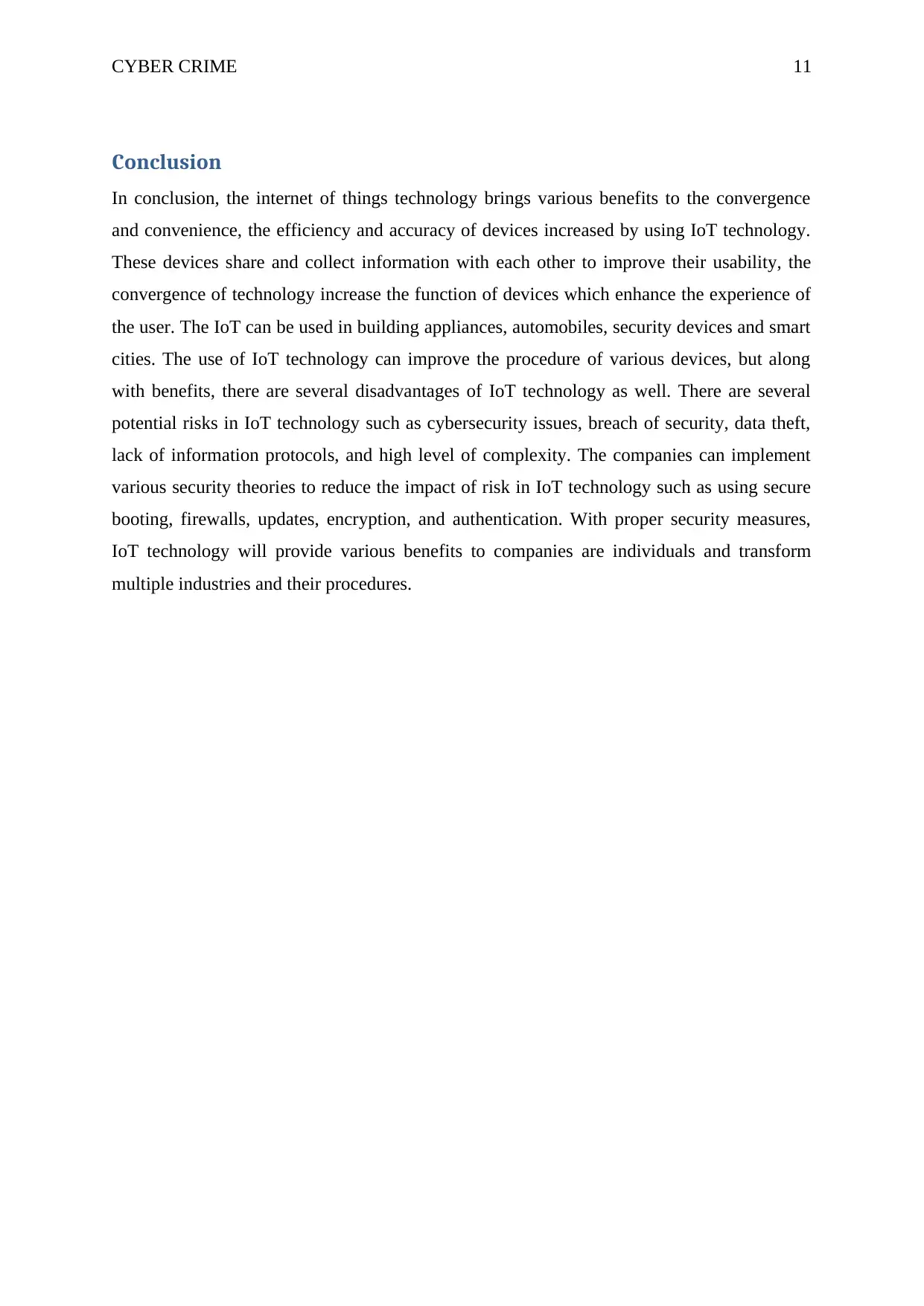
CYBER CRIME 11
Conclusion
In conclusion, the internet of things technology brings various benefits to the convergence
and convenience, the efficiency and accuracy of devices increased by using IoT technology.
These devices share and collect information with each other to improve their usability, the
convergence of technology increase the function of devices which enhance the experience of
the user. The IoT can be used in building appliances, automobiles, security devices and smart
cities. The use of IoT technology can improve the procedure of various devices, but along
with benefits, there are several disadvantages of IoT technology as well. There are several
potential risks in IoT technology such as cybersecurity issues, breach of security, data theft,
lack of information protocols, and high level of complexity. The companies can implement
various security theories to reduce the impact of risk in IoT technology such as using secure
booting, firewalls, updates, encryption, and authentication. With proper security measures,
IoT technology will provide various benefits to companies are individuals and transform
multiple industries and their procedures.
Conclusion
In conclusion, the internet of things technology brings various benefits to the convergence
and convenience, the efficiency and accuracy of devices increased by using IoT technology.
These devices share and collect information with each other to improve their usability, the
convergence of technology increase the function of devices which enhance the experience of
the user. The IoT can be used in building appliances, automobiles, security devices and smart
cities. The use of IoT technology can improve the procedure of various devices, but along
with benefits, there are several disadvantages of IoT technology as well. There are several
potential risks in IoT technology such as cybersecurity issues, breach of security, data theft,
lack of information protocols, and high level of complexity. The companies can implement
various security theories to reduce the impact of risk in IoT technology such as using secure
booting, firewalls, updates, encryption, and authentication. With proper security measures,
IoT technology will provide various benefits to companies are individuals and transform
multiple industries and their procedures.
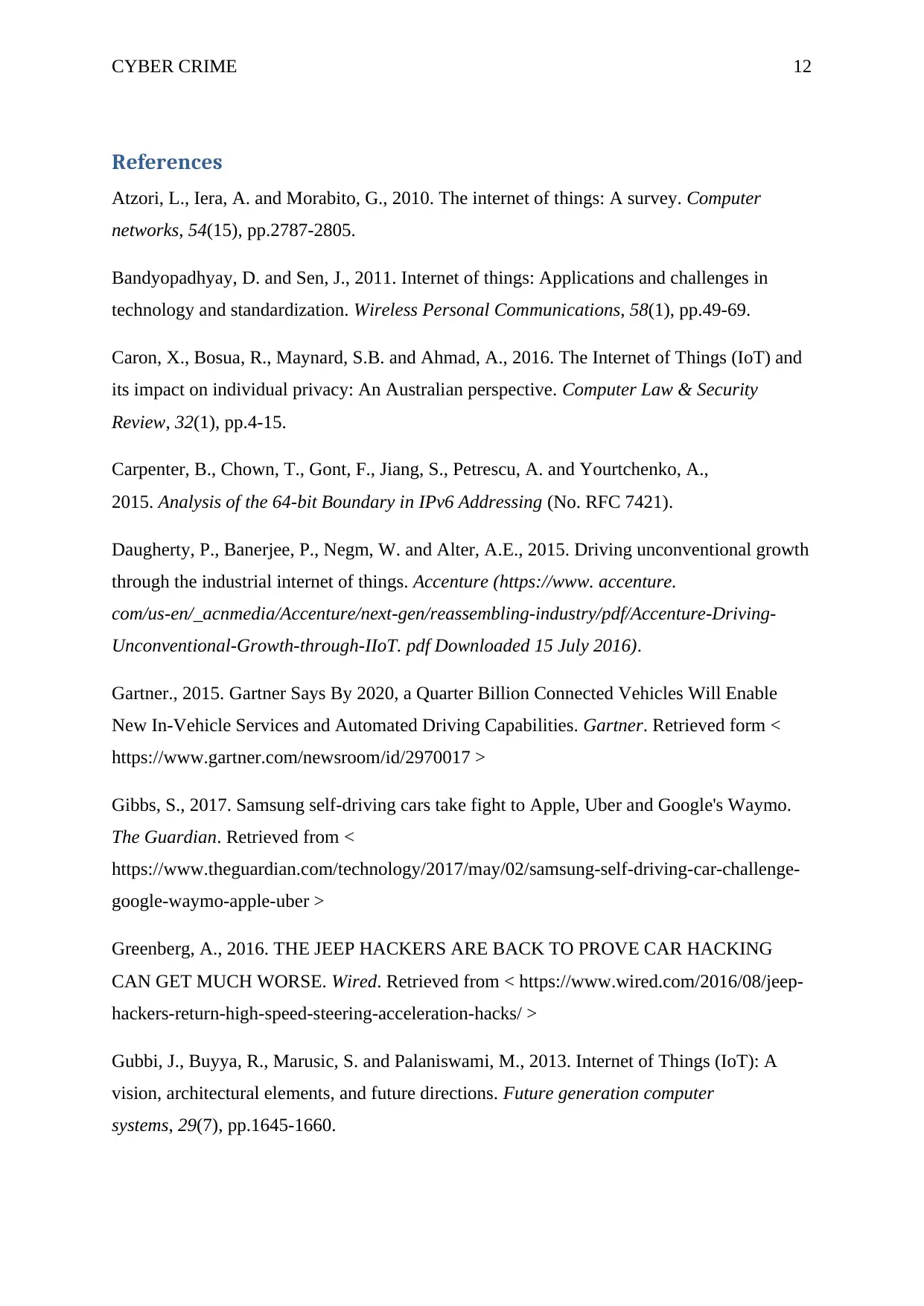
CYBER CRIME 12
References
Atzori, L., Iera, A. and Morabito, G., 2010. The internet of things: A survey. Computer
networks, 54(15), pp.2787-2805.
Bandyopadhyay, D. and Sen, J., 2011. Internet of things: Applications and challenges in
technology and standardization. Wireless Personal Communications, 58(1), pp.49-69.
Caron, X., Bosua, R., Maynard, S.B. and Ahmad, A., 2016. The Internet of Things (IoT) and
its impact on individual privacy: An Australian perspective. Computer Law & Security
Review, 32(1), pp.4-15.
Carpenter, B., Chown, T., Gont, F., Jiang, S., Petrescu, A. and Yourtchenko, A.,
2015. Analysis of the 64-bit Boundary in IPv6 Addressing (No. RFC 7421).
Daugherty, P., Banerjee, P., Negm, W. and Alter, A.E., 2015. Driving unconventional growth
through the industrial internet of things. Accenture (https://www. accenture.
com/us-en/_acnmedia/Accenture/next-gen/reassembling-industry/pdf/Accenture-Driving-
Unconventional-Growth-through-IIoT. pdf Downloaded 15 July 2016).
Gartner., 2015. Gartner Says By 2020, a Quarter Billion Connected Vehicles Will Enable
New In-Vehicle Services and Automated Driving Capabilities. Gartner. Retrieved form <
https://www.gartner.com/newsroom/id/2970017 >
Gibbs, S., 2017. Samsung self-driving cars take fight to Apple, Uber and Google's Waymo.
The Guardian. Retrieved from <
https://www.theguardian.com/technology/2017/may/02/samsung-self-driving-car-challenge-
google-waymo-apple-uber >
Greenberg, A., 2016. THE JEEP HACKERS ARE BACK TO PROVE CAR HACKING
CAN GET MUCH WORSE. Wired. Retrieved from < https://www.wired.com/2016/08/jeep-
hackers-return-high-speed-steering-acceleration-hacks/ >
Gubbi, J., Buyya, R., Marusic, S. and Palaniswami, M., 2013. Internet of Things (IoT): A
vision, architectural elements, and future directions. Future generation computer
systems, 29(7), pp.1645-1660.
References
Atzori, L., Iera, A. and Morabito, G., 2010. The internet of things: A survey. Computer
networks, 54(15), pp.2787-2805.
Bandyopadhyay, D. and Sen, J., 2011. Internet of things: Applications and challenges in
technology and standardization. Wireless Personal Communications, 58(1), pp.49-69.
Caron, X., Bosua, R., Maynard, S.B. and Ahmad, A., 2016. The Internet of Things (IoT) and
its impact on individual privacy: An Australian perspective. Computer Law & Security
Review, 32(1), pp.4-15.
Carpenter, B., Chown, T., Gont, F., Jiang, S., Petrescu, A. and Yourtchenko, A.,
2015. Analysis of the 64-bit Boundary in IPv6 Addressing (No. RFC 7421).
Daugherty, P., Banerjee, P., Negm, W. and Alter, A.E., 2015. Driving unconventional growth
through the industrial internet of things. Accenture (https://www. accenture.
com/us-en/_acnmedia/Accenture/next-gen/reassembling-industry/pdf/Accenture-Driving-
Unconventional-Growth-through-IIoT. pdf Downloaded 15 July 2016).
Gartner., 2015. Gartner Says By 2020, a Quarter Billion Connected Vehicles Will Enable
New In-Vehicle Services and Automated Driving Capabilities. Gartner. Retrieved form <
https://www.gartner.com/newsroom/id/2970017 >
Gibbs, S., 2017. Samsung self-driving cars take fight to Apple, Uber and Google's Waymo.
The Guardian. Retrieved from <
https://www.theguardian.com/technology/2017/may/02/samsung-self-driving-car-challenge-
google-waymo-apple-uber >
Greenberg, A., 2016. THE JEEP HACKERS ARE BACK TO PROVE CAR HACKING
CAN GET MUCH WORSE. Wired. Retrieved from < https://www.wired.com/2016/08/jeep-
hackers-return-high-speed-steering-acceleration-hacks/ >
Gubbi, J., Buyya, R., Marusic, S. and Palaniswami, M., 2013. Internet of Things (IoT): A
vision, architectural elements, and future directions. Future generation computer
systems, 29(7), pp.1645-1660.
Paraphrase This Document
Need a fresh take? Get an instant paraphrase of this document with our AI Paraphraser
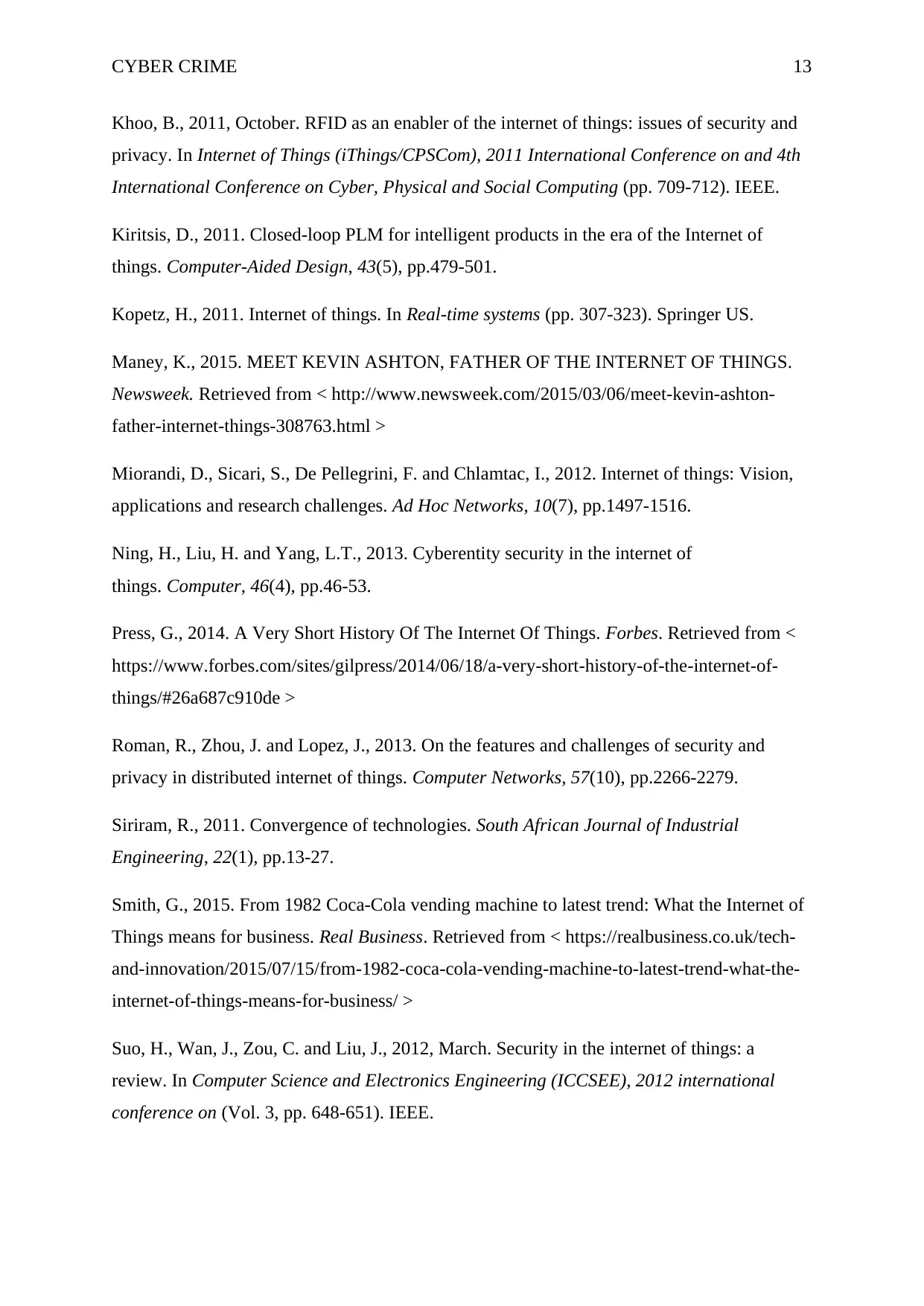
CYBER CRIME 13
Khoo, B., 2011, October. RFID as an enabler of the internet of things: issues of security and
privacy. In Internet of Things (iThings/CPSCom), 2011 International Conference on and 4th
International Conference on Cyber, Physical and Social Computing (pp. 709-712). IEEE.
Kiritsis, D., 2011. Closed-loop PLM for intelligent products in the era of the Internet of
things. Computer-Aided Design, 43(5), pp.479-501.
Kopetz, H., 2011. Internet of things. In Real-time systems (pp. 307-323). Springer US.
Maney, K., 2015. MEET KEVIN ASHTON, FATHER OF THE INTERNET OF THINGS.
Newsweek. Retrieved from < http://www.newsweek.com/2015/03/06/meet-kevin-ashton-
father-internet-things-308763.html >
Miorandi, D., Sicari, S., De Pellegrini, F. and Chlamtac, I., 2012. Internet of things: Vision,
applications and research challenges. Ad Hoc Networks, 10(7), pp.1497-1516.
Ning, H., Liu, H. and Yang, L.T., 2013. Cyberentity security in the internet of
things. Computer, 46(4), pp.46-53.
Press, G., 2014. A Very Short History Of The Internet Of Things. Forbes. Retrieved from <
https://www.forbes.com/sites/gilpress/2014/06/18/a-very-short-history-of-the-internet-of-
things/#26a687c910de >
Roman, R., Zhou, J. and Lopez, J., 2013. On the features and challenges of security and
privacy in distributed internet of things. Computer Networks, 57(10), pp.2266-2279.
Siriram, R., 2011. Convergence of technologies. South African Journal of Industrial
Engineering, 22(1), pp.13-27.
Smith, G., 2015. From 1982 Coca-Cola vending machine to latest trend: What the Internet of
Things means for business. Real Business. Retrieved from < https://realbusiness.co.uk/tech-
and-innovation/2015/07/15/from-1982-coca-cola-vending-machine-to-latest-trend-what-the-
internet-of-things-means-for-business/ >
Suo, H., Wan, J., Zou, C. and Liu, J., 2012, March. Security in the internet of things: a
review. In Computer Science and Electronics Engineering (ICCSEE), 2012 international
conference on (Vol. 3, pp. 648-651). IEEE.
Khoo, B., 2011, October. RFID as an enabler of the internet of things: issues of security and
privacy. In Internet of Things (iThings/CPSCom), 2011 International Conference on and 4th
International Conference on Cyber, Physical and Social Computing (pp. 709-712). IEEE.
Kiritsis, D., 2011. Closed-loop PLM for intelligent products in the era of the Internet of
things. Computer-Aided Design, 43(5), pp.479-501.
Kopetz, H., 2011. Internet of things. In Real-time systems (pp. 307-323). Springer US.
Maney, K., 2015. MEET KEVIN ASHTON, FATHER OF THE INTERNET OF THINGS.
Newsweek. Retrieved from < http://www.newsweek.com/2015/03/06/meet-kevin-ashton-
father-internet-things-308763.html >
Miorandi, D., Sicari, S., De Pellegrini, F. and Chlamtac, I., 2012. Internet of things: Vision,
applications and research challenges. Ad Hoc Networks, 10(7), pp.1497-1516.
Ning, H., Liu, H. and Yang, L.T., 2013. Cyberentity security in the internet of
things. Computer, 46(4), pp.46-53.
Press, G., 2014. A Very Short History Of The Internet Of Things. Forbes. Retrieved from <
https://www.forbes.com/sites/gilpress/2014/06/18/a-very-short-history-of-the-internet-of-
things/#26a687c910de >
Roman, R., Zhou, J. and Lopez, J., 2013. On the features and challenges of security and
privacy in distributed internet of things. Computer Networks, 57(10), pp.2266-2279.
Siriram, R., 2011. Convergence of technologies. South African Journal of Industrial
Engineering, 22(1), pp.13-27.
Smith, G., 2015. From 1982 Coca-Cola vending machine to latest trend: What the Internet of
Things means for business. Real Business. Retrieved from < https://realbusiness.co.uk/tech-
and-innovation/2015/07/15/from-1982-coca-cola-vending-machine-to-latest-trend-what-the-
internet-of-things-means-for-business/ >
Suo, H., Wan, J., Zou, C. and Liu, J., 2012, March. Security in the internet of things: a
review. In Computer Science and Electronics Engineering (ICCSEE), 2012 international
conference on (Vol. 3, pp. 648-651). IEEE.
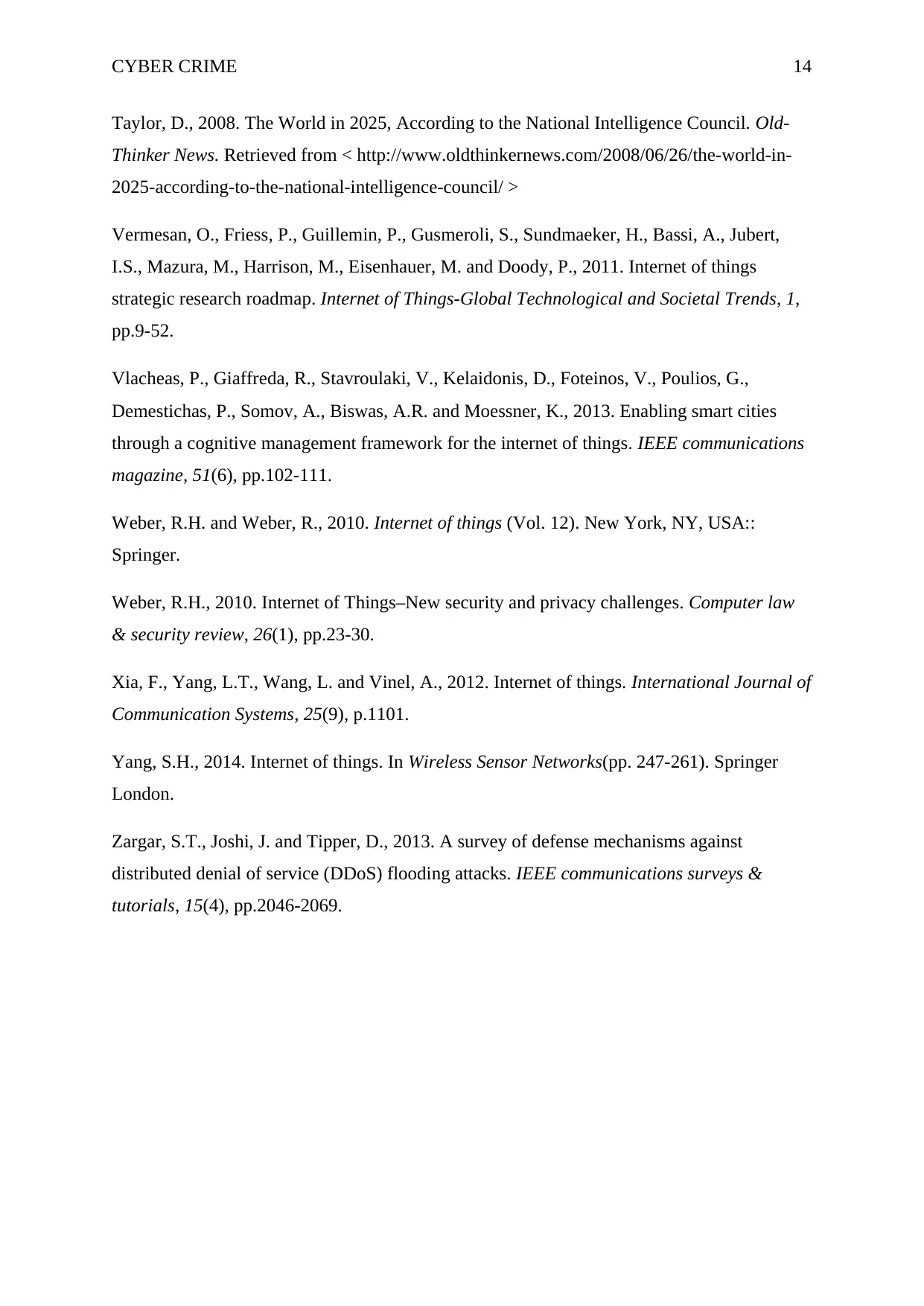
CYBER CRIME 14
Taylor, D., 2008. The World in 2025, According to the National Intelligence Council. Old-
Thinker News. Retrieved from < http://www.oldthinkernews.com/2008/06/26/the-world-in-
2025-according-to-the-national-intelligence-council/ >
Vermesan, O., Friess, P., Guillemin, P., Gusmeroli, S., Sundmaeker, H., Bassi, A., Jubert,
I.S., Mazura, M., Harrison, M., Eisenhauer, M. and Doody, P., 2011. Internet of things
strategic research roadmap. Internet of Things-Global Technological and Societal Trends, 1,
pp.9-52.
Vlacheas, P., Giaffreda, R., Stavroulaki, V., Kelaidonis, D., Foteinos, V., Poulios, G.,
Demestichas, P., Somov, A., Biswas, A.R. and Moessner, K., 2013. Enabling smart cities
through a cognitive management framework for the internet of things. IEEE communications
magazine, 51(6), pp.102-111.
Weber, R.H. and Weber, R., 2010. Internet of things (Vol. 12). New York, NY, USA::
Springer.
Weber, R.H., 2010. Internet of Things–New security and privacy challenges. Computer law
& security review, 26(1), pp.23-30.
Xia, F., Yang, L.T., Wang, L. and Vinel, A., 2012. Internet of things. International Journal of
Communication Systems, 25(9), p.1101.
Yang, S.H., 2014. Internet of things. In Wireless Sensor Networks(pp. 247-261). Springer
London.
Zargar, S.T., Joshi, J. and Tipper, D., 2013. A survey of defense mechanisms against
distributed denial of service (DDoS) flooding attacks. IEEE communications surveys &
tutorials, 15(4), pp.2046-2069.
Taylor, D., 2008. The World in 2025, According to the National Intelligence Council. Old-
Thinker News. Retrieved from < http://www.oldthinkernews.com/2008/06/26/the-world-in-
2025-according-to-the-national-intelligence-council/ >
Vermesan, O., Friess, P., Guillemin, P., Gusmeroli, S., Sundmaeker, H., Bassi, A., Jubert,
I.S., Mazura, M., Harrison, M., Eisenhauer, M. and Doody, P., 2011. Internet of things
strategic research roadmap. Internet of Things-Global Technological and Societal Trends, 1,
pp.9-52.
Vlacheas, P., Giaffreda, R., Stavroulaki, V., Kelaidonis, D., Foteinos, V., Poulios, G.,
Demestichas, P., Somov, A., Biswas, A.R. and Moessner, K., 2013. Enabling smart cities
through a cognitive management framework for the internet of things. IEEE communications
magazine, 51(6), pp.102-111.
Weber, R.H. and Weber, R., 2010. Internet of things (Vol. 12). New York, NY, USA::
Springer.
Weber, R.H., 2010. Internet of Things–New security and privacy challenges. Computer law
& security review, 26(1), pp.23-30.
Xia, F., Yang, L.T., Wang, L. and Vinel, A., 2012. Internet of things. International Journal of
Communication Systems, 25(9), p.1101.
Yang, S.H., 2014. Internet of things. In Wireless Sensor Networks(pp. 247-261). Springer
London.
Zargar, S.T., Joshi, J. and Tipper, D., 2013. A survey of defense mechanisms against
distributed denial of service (DDoS) flooding attacks. IEEE communications surveys &
tutorials, 15(4), pp.2046-2069.
1 out of 15
Related Documents
Your All-in-One AI-Powered Toolkit for Academic Success.
+13062052269
info@desklib.com
Available 24*7 on WhatsApp / Email
![[object Object]](/_next/static/media/star-bottom.7253800d.svg)
Unlock your academic potential
© 2024 | Zucol Services PVT LTD | All rights reserved.





